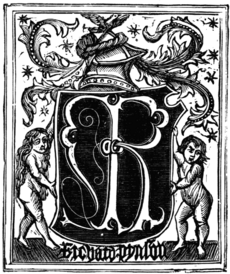Robert Fabyan facts for kids
Quick facts for kids Robert Fabyan |
|
|---|---|
| Spouse(s) | Elizabeth Pake |
| Issue | |
|
|
| Father | John Fabyan |
| Mother | Agnes (surname unknown) |
| Died | c.1512 London |
| Burial | St Michael's, Cornhill, London |
Robert Fabyan (died around 1512) was an important person in London. He was a draper (someone who sells cloth), a Sheriff (a high-ranking official), and an Alderman (a city council member). He is most famous for writing a history book called Fabyan's Chronicle.
Contents
About Robert Fabyan's Family
Robert Fabyan was the son of John Fabyan and his wife, Agnes. People believe he was born in London. He also had a brother named John.
Robert Fabyan's Career and Achievements

Robert Fabyan started his career learning to be a draper around 1470. He became a full member of the Worshipful Company of Drapers in 1476. This was a powerful group of cloth merchants in London.
His Roles in London City Government
Fabyan held many important jobs in the City of London:
- In 1485, he was a renter warden for the Drapers, helping manage their money.
- In 1486, he became an auditor for the City of London, checking the city's financial records.
- In 1493, he was chosen as a Sheriff. Sheriffs were important officials who helped keep law and order.
- The next year, in 1494, he became an alderman for the Farringdon Without area. Aldermen were like city council members.
- He was elected Master of the Drapers twice, in 1495 and again in 1501. This was the highest position in the Drapers' Company.
His Work for the King and City
Robert Fabyan also helped the King and the city in other ways. In 1496, he was chosen to talk to King Henry VII about taxes on cloth being sent from England to Flanders.
During a time of trouble called the Cornish Rebellion of 1497, Fabyan and two other men were in charge of making sure the city gates, Ludgate and Newgate, were safe. After the rebellion ended, he even traveled with the King. In 1498, he helped collect money to pay for a war in Scotland.
In 1503, he decided to step down from his role as alderman. He felt he didn't have enough money to become the Lord Mayor, which was a very expensive position to hold.
Writing Fabyan's Chronicle
Robert Fabyan is best known for his book, Fabyan's Chronicle. This book tells the history of both England and France at the same time. It starts with the legendary Brutus of Troy arriving in England and goes all the way up to the death of King Henry VII.
Even though the copies we have today weren't written by Fabyan himself, experts are almost sure he wrote the original text. The book was first printed in 1516 by Richard Pynson. Later, in 1533, another printer, William Rastell, put Fabyan's name on the cover.
Fabyan was one of the first London historians to list where he got his information. He used many older books and city records. The 1516 edition of his book faced some challenges. Later editions were printed in 1533, 1542, and 1559.
Robert Fabyan's Later Life and Death
Robert Fabyan was involved in managing his father-in-law's will. Through his wife, he inherited a house and land in Essex. When he died, he also owned properties in London and other towns in Essex.
Historians believe Robert Fabyan died around 1511 or 1512 in London. He was buried at St Michael's Cornhill church in London. In his will, which was approved in 1513, he left gifts to his wife, his six children, and other family members and friends.
Marriage and Children
Robert Fabyan married Elizabeth Pake. She was the daughter of John Pake, who was also a draper in London. Robert and Elizabeth had sixteen children together. However, only six of them were still alive when Robert Fabyan died. These six children were four sons named John, Robert, Thomas, and Anthony, and two daughters named Joan and Mary.

